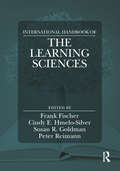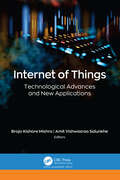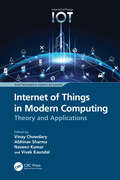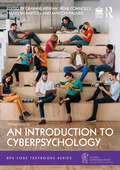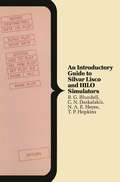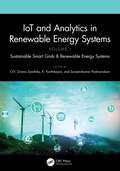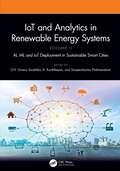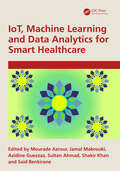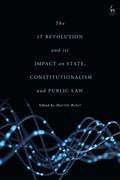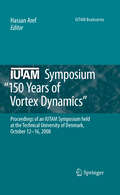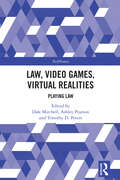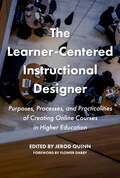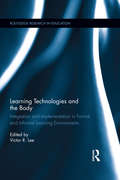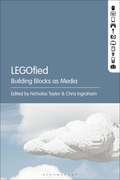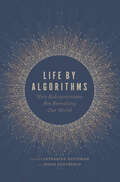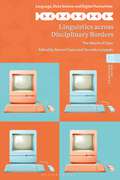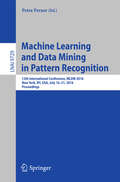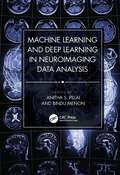- Table View
- List View
International Handbook of the Learning Sciences
The International Handbook of the Learning Sciences is a comprehensive collection of international perspectives on this interdisciplinary field. In more than 50 chapters, leading experts synthesize past, current, and emerging theoretical and empirical directions for learning sciences research. The three sections of the handbook capture, respectively: foundational contributions from multiple disciplines and the ways in which the learning sciences has fashioned these into its own brand of use-oriented theory, design, and evidence; learning sciences approaches to designing, researching, and evaluating learning broadly construed; and the methodological diversity of learning sciences research, assessment, and analytic approaches. This pioneering collection is the definitive volume of international learning sciences scholarship and an essential text for scholars in this area.
Internet der Dinge: Echtzeit 2016 (Informatik aktuell)
Mit seinem Workshop 2016 zum Thema "Internet der Dinge" bietet der GI/GMA/ITG-Fachausschuss Echtzeitsysteme Wissenschaftlern, Nutzern und Herstellern ein Forum an, auf dem neue Trends und Entwicklungen zu folgenden Programmschwerpunkten vorgestellt werden: Echtzeitfähigkeit, Funktionale Sicherheit, Datenschutz und Datensicherheit, Sichere Datenkommunikation, Schnittstellen, Protokolle und Plattformen, Energieeffizienz, Diensteabrechung- und Bezahlung, Erweiterte Realität (Augmented Reality), Altersgerechte Assistenzsysteme für selbstbestimmtes Lebenuns Ambient Assited Living. Berichte zu aktuellen Anwendungen und zur Ausbildung runden die Publikation ab.
Internet of Medical Things in Smart Healthcare: Post-COVID-19 Pandemic Scenario
The COVID-19 epidemic has helped to expand the function of the Internet of Medical Things in healthcare at an exponential rate. This book offers a comprehensive exploration of IoMT in the post-COVID-19 era, providing an overview of modern technologies used for the improvement of healthcare, such as IoT, artificial intelligence, robotics, big data, and wearable devices used in healthcare applications, with a focus on the detection and treatment of COVID-19 and related viruses. The volume presents the principles, state-of-the-art developments, architecture, real-world applications, actual case studies, results of IoMT experiments and sensor-based systems, and more. The chapters look at various aspects of artificial intelligence in IoMT-based telemedicine, health monitoring, early COVID detection, automatic intravenous fluids feeds, chest x-ray images, data collection for decision-making, security of health information, and more. This volume provides an understanding of the real applications, development of healthcare systems, architectural frameworks, and modern design elements of healthcare systems.
Internet of Things: Technological Advances and New Applications
The Internet of Things has revolutionized many industries and sectors by connecting devices to the Internet with the use of smart sensors and actuators, resulting in many advantages to businesses and organizations, such as better information and resource sharing, better supply chain efficiency, resulting in better overall efficiency and cost savings. This new book investigates the potential for initiating data-enabled and IoT-intensive applications to provide control and optimization of industrial operations and services. It presents an informative selection of quantitative research, case studies, conceptual chapters, model articles and theoretical papers on many important technological advances, applications, and challenges in the current status of IoT. The book features examples of IoT applications in such areas as food processing, automotive engineering, mental health, health tracking, security, and more. It discusses applying IoT in reverse logistics processes, developments in the Internet of Vehicles, the use of smart antennas, and machine learning in IoT. One chapter discusses a ground-breaking new device that uses IoT to convert audio recordings to Braille. Also discussed is the growing use of IoT in biometric technology (the use of technology to identify a person based on some aspect of their biology, such as fingerprint and eye unique pattern recognition). The enlightening information shared here offers state-of-the-art IoT solutions to many of today’s challenges of improving efficiency and bringing important information to the surface more quickly than systems depending on human intervention. The volume will be of value for computer science engineers and researchers, instructors and students in the field, and professionals that are interested in exploring the areas of next-generations IoT.
Internet of Things-Based Machine Learning in Healthcare: Technology and Applications
The Internet of Medical Things (IoMT) is a system that collects data from patients with the help of different sensory inputs, e.g., an accelerometer, electrocardiography, and electroencephalography. This text presents both theoretical and practical concepts related to the application of machine learning and Internet of Things (IoT) algorithms in analyzing data generated through healthcare systems. Illustrates the latest technologies in the healthcare domain and the Internet of Things infrastructure for storing smart electronic health records Focuses on the importance of machine learning algorithms and the significance of Internet of Things infrastructure for healthcare systems Showcases the application of fog computing architecture and edge computing in novel aspects of modern healthcare services Discusses unsupervised genetic algorithm-based automatic heart disease prediction Covers Internet of Things–based hardware mechanisms and machine learning algorithms to predict the stress level of patients The text is primarily written for graduate students and academic researchers in the fields of computer science and engineering, biomedical engineering, electrical engineering, and information technology.
Internet of Things in Modern Computing: Theory and Applications (Smart Technologies for Engineers and Scientists)
The text focuses on the theory, design, and implementation of the Internet of Things (IoT), in a modern communication system. It will be useful to senior undergraduate, graduate students, and researchers in diverse fields domains including electrical engineering, electronics and communications engineering, computer engineering, and information technology. Features: Presents all the necessary information on the Internet of Things in modern computing Examines antenna integration challenges and constraints in the Internet of Things devices Discusses advanced Internet of Things networks and advanced controllers required for modern architecture Explores security and privacy challenges for the Internet of Things-based health care system Covers implementation of Internet of Things security protocols such as MQTT, Advanced Message Queuing Protocol, XMPP, and DSS The text addresses the issues and challenges in implementing communication and security protocols for IoT in modern computing. It further highlights the applications of IoT in diverse areas including remote health monitoring, remote monitoring of vehicle data and environmental characteristics, industry 4.0, 5G communications, and Next-gen IoT networks. The text presents case studies on IoT in modern digital computing. It will serve as an ideal reference text for senior undergraduate, graduate students, and academic researchers in diverse fields domains including electrical engineering, electronics and communications engineering, computer engineering, and information technology.
Internet of Things Security: Fundamentals, Techniques and Applications
Internet of Things (IoT) security deals with safeguarding the devices and communications of IoT systems, by implementing protective measures and avoiding procedures which can lead to intrusions and attacks. However, security was never the prime focus during the development of the IoT, hence vendors have sold IoT solutions without thorough preventive measures. The idea of incorporating networking appliances in IoT systems is relatively new, and hence IoT security has not always been considered in the product design. To improve security, an IoT device that needs to be directly accessible over the Internet should be segmented into its own network, and have general network access restricted. The network segment should be monitored to identify potential anomalous traffic, and action should be taken if a problem arises. This has generated an altogether new area of research, which seeks possible solutions for securing the devices, and communication amongst them.
An Introduction to Cyberpsychology (BPS Core Textbooks Series)
An Introduction to Cyberpsychology provides a comprehensive introduction to this rapidly growing discipline. Fully updated in its second edition, the book encourages students to critically evaluate the psychology of online interactions and to develop appropriate research methodologies to complete their own work in this field.The book examines cyberpsychology and online research methodologies, social psychology in an online context, practical applications of cyberpsychology, and the psychological aspects of other technologies. This new edition has been carefully updated to include additional coverage of: Expanded content relating to major developments in the field and new content on gaming and screentime A new chapter examining the relationship between older adults and technology Cyberpsychology in focus feature boxes in each chapter that examine topics in depth Interviews with professionals working in fields relating to cyberpsychology Each chapter includes key terms and a glossary, content summaries, discussion questions, and recommended reading to guide further study.Supported by extensive online resources for students and instructors, this authoritative book is an essential core text for undergraduate modules in cyberpsychology, and an ideal primer for students of postgraduate programs in cyberpsychology.To view the additional student and instructor resources for this book, please visit bpscoretextbooks.routledge.com
IoT and Analytics in Renewable Energy Systems (Volume 1): Sustainable Smart Grids & Renewable Energy Systems
Smart grid technologies include sensing and measurement technologies, advanced components aided with communications and control methods along with improved interfaces and decision support systems. Smart grid techniques support the extensive inclusion of clean renewable generation in power systems. Smart grid use also promotes energy saving in power systems. Cyber security objectives for the smart grid are availability, integrity and confidentiality. Five salient features of this book are as follows: AI and IoT in improving resilience of smart energy infrastructure IoT, smart grids and renewable energy: an economic approach AI and ML towards sustainable solar energy Electrical vehicles and smart grid Intelligent condition monitoring for solar and wind energy systems
IoT and Analytics in Renewable Energy Systems (Volume 2): AI, ML and IoT Deployment in Sustainable Smart Cities
Smart cities emanate from a smart renewable-energy-aided power grid. The smart grid technologies offer an array of benefits like reliability, availability, and resiliency. Smart grids phenomenally contribute to facilitating cities reaching those sustainability goals over time. Digital technologies, such as the Internet of Things (IoT), automation, artificial intelligence (AI) and machine learning (ML) significantly contribute to the two-way communication between utilities and customers in smart cities. Five salient features of this book are as follows: Smart grid to the smart customer Intelligent computing for smart grid applications Novel designs of IoT systems such as smart healthcare, smart transportation, smart home, smart agriculture, smart manufacturing, smart grid, smart education, smart government, smart traffic management systems Innovations in using IoT and AI in improving resilience of smart energy infrastructure Challenges and future research directions of smart city applications
IoT, Machine Learning and Data Analytics for Smart Healthcare
Machine learning, Internet of Things (IoT) and data analytics are new and fresh technologies that are being increasingly adopted in the field of medicine. This book positions itself at the forefront of this movement, exploring the beneficial applications of these new technologies and how they are gradually creating a smart healthcare system. This book details the various ways in which machine learning, data analytics and IoT solutions are instrumental in disease prediction in smart healthcare. For example, wearable sensors further help doctors and healthcare managers to monitor patients remotely and collect their health parameters in real-time, which can then be used to create datasets to develop machine learning models that can aid in the prediction and detection of any susceptible disease. In this way, smart healthcare can provide novel solutions to traditional medical issues. This book is a useful overview for scientists, researchers, practitioners and academics specialising in the field of intelligent healthcare, as well as containing additional appeal as a reference book for undergraduate and graduate students
The IT Revolution and its Impact on State, Constitutionalism and Public Law
What is the future of constitutionalism, state and law in the new technological age? This edited collection explores the different aspects of the impact of information and technology revolution on state, constitutionalism and public law. Leading European scholars in the fields of constitutional, administrative, financial and EU law provide answers to fascinating conceptual questions including:- What are the challenges of information and technological revolution to sovereignty? - How will information and technology revolution impact democracy and the public sphere? - What are the disruptive effects of social media platforms on democratic will-formation processes and how can we regulate the democratic process in the digital age? - What are the main challenges to courts and administrations in the algorithmic society? - What is the impact of artificial intelligence on administrative law and social and health services? - What is the impact of information and technology revolution on data protection, privacy and human rights?
IUTAM Symposium on 150 Years of Vortex Dynamics: Proceedings of the IUTAM Symposium “150 Years of Vortex Dynamics” held at the Technical University of Denmark, October 12-16, 2008 (IUTAM Bookseries #20)
In 1858 Hermann von Helmholtz published a paper that today is recognized as the foundation of vortex dynamics. To celebrate the sesquicentennial of Helmholtz’s paper, IUTAM sponsored a symposium that was held at the technical university of Denmark in October 2008. The papers presented at the symposium gave a good overview of where the field of vortex dynamics stands today. This volume contains almost all of the papers presented as lectures at the symposium, and also a few of the poster papers. In this volume the reader will find up-to-date, state-of-theart papers on Point vortices, vortex sheets, vortex filaments, vortex rings, vortex patches, vortex streets, the vortex dynamics of swimming and flying, vortex knots, vortices in turbulent flows, vortices in computational fluid dynamics, the topology of vortex wakes, stability of vortex configurations, vortices on a sphere, geophysical vortices, cosmic vortices and much more.
Law and Emerging Issues: Proceedings of the International Conference on Law and Emerging Issues (ICLEI 2023)
In the ever-evolving landscape of law and governance, adaptation and innovation are key to addressing the challenges of our times. This edited volume is a testament to the ever-evolving nature of the legal field and the ongoing efforts of legal scholars and academicians to dissect, analyze, and grapple with the challenges and opportunities presented by these changes. The topics covered in this book span a wide spectrum of legal domains, reflecting the complex and rapidly changing nature of our contemporary world. From corporate governance structures to emerging challenges in the digital space, from analyzing the implications of the Social Security Code 2020 in India to understanding the legal developments surrounding unorganized migrant workers during the COVID-19 pandemic, the breadth of subjects addressed here is both impressive and vital.
Law and Emerging Issues: Proceedings of the International Conference on Law and Emerging Issues (ICLEI 2023)
In the ever-evolving landscape of law and governance, adaptation and innovation are key to addressing the challenges of our times. This edited volume is a testament to the ever-evolving nature of the legal field and the ongoing efforts of legal scholars and academicians to dissect, analyze, and grapple with the challenges and opportunities presented by these changes. The topics covered in this book span a wide spectrum of legal domains, reflecting the complex and rapidly changing nature of our contemporary world. From corporate governance structures to emerging challenges in the digital space, from analyzing the implications of the Social Security Code 2020 in India to understanding the legal developments surrounding unorganized migrant workers during the COVID-19 pandemic, the breadth of subjects addressed here is both impressive and vital.
Law, Video Games, Virtual Realities: Playing Law (TechNomos)
This edited volume explores the intersection between the coded realm of the video game and the equally codified space of law through an insightful collection of critical readings. Law is the ultimate multiplayer role-playing game. Involving a process of world-creation, law presents and codifies the parameters of licit and permitted behaviour, requiring individuals to engage their roles as a legal subject – the player-avatar of law – in order to be recognised, perform legal actions, activate rights or fulfil legal duties. Although traditional forms of law (copyright, property, privacy, freedom of expression) externally regulate the permissible content, form, dissemination, rights and behaviours of game designers, publishers, and players, this collection examines how players simulate, relate, and engage with environments and experiences shaped by legality in the realm of video game space. Featuring critical readings of video games as a means of understanding law and justice, this book contributes to the developing field of cultural legal studies, but will also be of interest to other legal theorists, socio-legal scholars, and games theorists.
The Learner-Centered Instructional Designer: Purposes, Processes, and Practicalities of Creating Online Courses in Higher Education
“What does a new instructional designer need to know to find her or his feet when working with faculty to create online classes?” This is a practical handbook for established and aspiring instructional designers in higher education, readers who may also be identified by such professional titles as educational developer, instructional technologist, or online learning specialist. Jerod Quinn, together with a team of experienced instructional designers who have worked extensively with a wide range of faculty on a multiplicity of online courses across all types of institutions, offer key guiding principles, insights and advice on how to develop productive and collegial partnerships with faculty to deliver courses that engage students and promote enduring learning.Designing and developing online classes for higher education takes a combination of pedagogical knowledge, the ability to build trust with faculty, familiarity with frameworks on how people learn, understanding of accessibility and inclusion, and technical skills to leverage a learning management system into an educational experience. Coming from diverse backgrounds, few instructional designers enter academia well versed in all of these aspects of creating online classes. This book provides the foundation on which instructional designers can build their careers. The guiding principle that animates this book is that the student experience and successful learning outcomes are paramount, and governs discussion of course design, pedagogy, the use of multimedia and technological advances, as well as the use of different forms of interactive exercises and group assignments. The succinct, informally written chapters offer ideas and means to apply theory to the daily work of instructional design and cover the four key components that drive this work in higher education: ·Defining the scope and main design approaches of our work·Building trust with the faculty we work with·Applying frameworks of how people learn·Mastering common online instructional practices.
Learning Technologies and the Body: Integration and Implementation In Formal and Informal Learning Environments (Routledge Research in Education)
This volume explores how technology-supported learning environments can incorporate physical activity and interactive experiences in formal education. It presents cutting-edge research and design work on a new generation of "body-centric" technologies such as wearable body sensors, GPS tracking devices, interactive display surfaces, video game controller devices, and humanlike avatars. Contributors discuss how and why each of these technologies can be used in service of learning within K-12 classrooms and at home, in museums and online. Citing examples of empirical evidence and specific implementation, this timely and critical volume examines how body responsive technologies are being used within the educational community to advance the next generation of educational technology.
LEGOfied: Building Blocks as Media
LEGOfied: Building Blocks as Media offers a multi-faceted exploration of LEGO fandom, addressing a blindspot in current accounts of LEGO and an emerging area of interest to media scholars: namely, the role of hobbyist enthusiasts and content producers in LEGO's emergence as a ubiquitous transmedia franchise. This book examines a range of LEGO hobbyism and their attendant forms of mediated self-expression and identity (their “technicities”): artists, aspiring Master Builders, collectors, and entrepreneurs who refashion LEGO bricks into new commodities (sets, tchotchkes, and minifigures). The practices and perspectives that constitute this diverse scene lie at the intersection of multiple transformations in contemporary culture, including the shifting relationships between culture industries and the audiences that form their most ardent consumer base, but also the emerging forms of entrepreneurialism, professionalization, and globalization that characterize the burgeoning DIY movement. The major aim of this edited volume, and what makes it a compelling project for media scholars, is its rigorous, mutli-dimensional articulation of how LEGO functions not just as toy, as cultural icon, or as transmedia franchise, but as a media platform. LEGOfied is centered around their shared experiences, qualitative observations, and semi-structured interviews at a number of LEGO hobbyist conventions. Working outwards from these conventions, each chapter of the book engages additional modes of inquiry -- media archaeology, aesthetics, posthumanist philosophy, feminist media studies, and science and technology studies -- to explore the origins, permutations and implications of different aspects of the contemporary LEGO fandom scene.
Life by Algorithms: How Roboprocesses Are Remaking Our World
Computerized processes are everywhere in our society. They are the automated phone messaging systems that businesses use to screen calls; the link between student standardized test scores and public schools’ access to resources; the algorithms that regulate patient diagnoses and reimbursements to doctors. The storage, sorting, and analysis of massive amounts of information have enabled the automation of decision-making at an unprecedented level. Meanwhile, computers have offered a model of cognition that increasingly shapes our approach to the world. The proliferation of “roboprocesses” is the result, as editors Catherine Besteman and Hugh Gusterson observe in this rich and wide-ranging volume, which features contributions from a distinguished cast of scholars in anthropology, communications, international studies, and political science. Although automatic processes are designed to be engines of rational systems, the stories in Life by Algorithms reveal how they can in fact produce absurd, inflexible, or even dangerous outcomes. Joining the call for “algorithmic transparency,” the contributors bring exceptional sensitivity to everyday sociality into their critique to better understand how the perils of modern technology affect finance, medicine, education, housing, the workplace, food production, public space, and emotions—not as separate problems but as linked manifestations of a deeper defect in the fundamental ordering of our society. Contributors Catherine Besteman, Alex Blanchette, Robert W. Gehl, Hugh Gusterson, Catherine Lutz, Ann Lutz Fernandez, Joseph Masco, Sally Engle Merry, Keesha M. Middlemass, Noelle Stout, Susan J. Terrio
Linguistics across Disciplinary Borders: The March of Data (Language, Data Science and Digital Humanities)
This volume highlights the ways in which recent developments in corpus linguistics and natural language processing can engage with topics across language studies, humanities and social science disciplines.New approaches have emerged in recent years that blur disciplinary boundaries, facilitated by factors such as the application of computational methods, access to large data sets, and the sharing of code, as well as continual advances in technologies related to data storage, retrieval, and processing. The “march of data” denotes an area at the border region of linguistics, humanities, and social science disciplines, but also the inevitable development of the underlying technologies that drive analysis in these subject areas.Organized into 3 sections, the chapters are connected by the underlying thread of linguistic corpora: how they can be created, how they can shed light on varieties or registers, and how their metadata can be utilized to better understand the internal structure of similar resources. While some chapters in the volume make use of well-established existing corpora, others analyze data from platforms such as YouTube, Twitter or Reddit. The volume provides insight into the diversity of methods, approaches, and corpora that inform our understanding of the “border regions” between the realms of data science, language/linguistics, and social or cultural studies.
Literature and Computation: Platform Intermediality, Hermeneutic Modeling, and Analytical-Creative Approaches (Routledge New Textual Studies in Literature)
Literature and Computation presents some of the most relevantly innovative recent approaches to literary practice, theory, and criticism as driven by computation and situated in digital environments. These approaches rely on automated analyses, but use them creatively, engage in text modeling but inform it with qualitative[-interpretive] critical possibilities, and contribute to present-day platform culture in revolutionizing intermedial ways. While such new directions involve more and more sophisticated machine learning and artificial intelligence, they also mark a spectacular return of the (trans)human(istic) and of traditional-modern literary or urgent political, gender, and minority-related concerns and modes now addressed in ever subtler and more nuanced ways within human-computer interaction frameworks. Expanding the boundaries of literary and data studies, digital humanities, and electronic literature, the featured contributions unveil an emerging landscape of trailblazing practice and theoretical crossovers ready and able to spawn and/or chart the witness literature of our age and cultures.
Machine Learning and Data Mining in Pattern Recognition: 12th International Conference, MLDM 2016, New York, NY, USA, July 16-21, 2016, Proceedings (Lecture Notes in Computer Science #9729)
This book constitutes the refereed proceedings of the 12th International Conference on Machine Learning and Data Mining in Pattern Recognition, MLDM 2016, held in New York, NY, USA in July 2016. The 58 regular papers presented in this book were carefully reviewed and selected from 169 submissions. The topics range from theoretical topics for classification, clustering, association rule and pattern mining to specific data mining methods for the different multimedia data types such as image mining, text mining, video mining and Web mining.
Machine Learning and Deep Learning in Neuroimaging Data Analysis
Machine learning (ML) and deep learning (DL) have become essential tools in healthcare. They are capable of processing enormous amounts of data to find patterns and are also adopted into methods that manage and make sense of healthcare data, either electronic healthcare records or medical imagery. This book explores how ML/DL can assist neurologists in identifying, classifying or predicting neurological problems that require neuroimaging. With the ability to model high-dimensional datasets, supervised learning algorithms can help in relating brain images to behavioral or clinical observations and unsupervised learning can uncover hidden structures/patterns in images. Bringing together artificial intelligence (AI) experts as well as medical practitioners, these chapters cover the majority of neuro problems that use neuroimaging for diagnosis, along with case studies and directions for future research.
